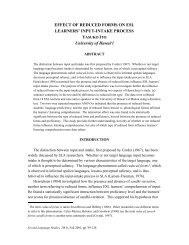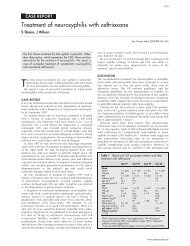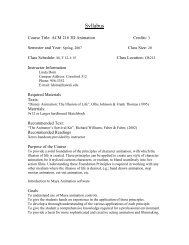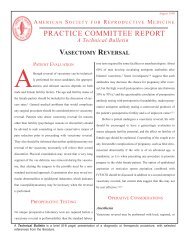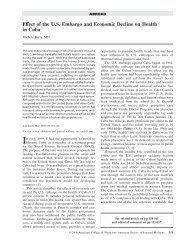Tying and Untying the Trouser-Cord - University of Hawaii
Tying and Untying the Trouser-Cord - University of Hawaii
Tying and Untying the Trouser-Cord - University of Hawaii
Create successful ePaper yourself
Turn your PDF publications into a flip-book with our unique Google optimized e-Paper software.
52 J. W. Frembgen<br />
with cowries (to ward <strong>of</strong>f <strong>the</strong> ‘evil eye’ <strong>and</strong> representing a symbol <strong>of</strong> fertility) as well<br />
as an additional belt with two round buckles (symbolising matrimony), which is<br />
given by <strong>the</strong> family <strong>of</strong> <strong>the</strong> bridegroom (Andrews 1985, p. 663; Loschek 1993, p. 56). In<br />
Tunisia, <strong>the</strong> bride’s virginity is protected by a chain tied around her waist <strong>and</strong> closed<br />
by a padlock (Louis 1976, pp. 169 /70). The broad belt <strong>of</strong> <strong>the</strong> Moroccan bride is<br />
ceremonially untied on <strong>the</strong> nuptial night to symbolise her willingness for sexual<br />
intercourse. As elsewhere in North Africa, she does not wear her belt again before <strong>the</strong><br />
seventh day (‘<strong>the</strong> day <strong>of</strong> <strong>the</strong> belt’) after <strong>the</strong> wedding. 5 Then a special ceremony, called<br />
tahzim (‘putting on <strong>the</strong> belt’), marks <strong>the</strong> end <strong>of</strong> this potent period. Before <strong>the</strong><br />
beginning <strong>of</strong> <strong>the</strong> twentieth century, in <strong>the</strong> area <strong>of</strong> Es-Salt in Jordan, women used to<br />
wear a special type <strong>of</strong> cloth belt fastened with about nine woven strings with tassels<br />
(Völger et al. 1987, p. 379). It is said that on <strong>the</strong> occasion <strong>of</strong> a pilgrimage, one <strong>of</strong> <strong>the</strong>se<br />
strings was knotted to <strong>the</strong> railing <strong>of</strong> a saint’s tomb that a wish (usually for <strong>the</strong> birth <strong>of</strong><br />
a son) might be fulfilled. For <strong>the</strong> same reason, in <strong>the</strong> practical veneration <strong>of</strong> Muslim<br />
saints in <strong>the</strong> Maghrib, women sometimes deposit <strong>the</strong>ir belts at a shrine <strong>and</strong> put <strong>the</strong>m<br />
on again before <strong>the</strong>y leave. 6<br />
The ethnographic data presented above (which are, <strong>of</strong> course, not exhaustive with<br />
respect to <strong>the</strong> topic <strong>of</strong> symbolic ties) show that belt <strong>and</strong> loincloth can be understood<br />
as protective in a moral sense, ensuring purity <strong>and</strong> thus a strength-giving power, but<br />
also referring to fertility. The same holds true for ano<strong>the</strong>r item <strong>of</strong> clothing explicitly<br />
related to sexuality, namely <strong>the</strong> somewhat more intimate trouser-cord. Already in <strong>the</strong><br />
Abbasid period, Arabic strings were decorated with inscriptions <strong>of</strong> poetic, erotic, <strong>and</strong><br />
even lewd character (Ibn al-Wasˇsˇa 1984, pp. 157 /8.) The drawstring is a sort <strong>of</strong> ‘inner<br />
belt’ that secures <strong>and</strong> holds up <strong>the</strong> loose trousers <strong>and</strong> <strong>the</strong>reby prevents <strong>the</strong>m from<br />
falling down <strong>and</strong> exposing <strong>the</strong> wearer.<br />
<strong>Trouser</strong>-<strong>Cord</strong>, <strong>the</strong> ‘Inner Belt’<br />
The use <strong>of</strong> baggy trousers (shalwar, pajama) as both a male <strong>and</strong> a female lower<br />
garment is common among Muslims in <strong>the</strong> Middle East <strong>and</strong> South Asia, especially in<br />
Pakistan, where it has become <strong>the</strong> national dress (Dar 1969, pp. 92 /3; Taylor 1993,<br />
pp. 38, 41 /2; Banerjee & Miller 2003, pp. 5, 238 /48). 7 Here <strong>the</strong> cord is part <strong>of</strong> a<br />
dress, shalwar-qamiz (trousers <strong>and</strong> knee-length tunic), originally coming from Iran<br />
where it is worn in regionally different styles. Similarly, kurta-pajama is <strong>the</strong> Indian<br />
Muslim dress. It is appropriate for a hot climate <strong>and</strong> allows <strong>the</strong> unhindered carrying<br />
out <strong>of</strong> <strong>the</strong> praying positions. Particularly within political Islamism, this type <strong>of</strong> dress<br />
has been labelled as ‘Islamic’.<br />
Following Muslim etiquette that clothing should conceal <strong>and</strong> not reveal <strong>the</strong> shape<br />
<strong>of</strong> <strong>the</strong> body (Shad 1985, pp. 13 /20), <strong>the</strong> loose trousers are <strong>of</strong>ten voluminous, having<br />
a waist circumference three or four times <strong>the</strong> size <strong>of</strong> <strong>the</strong> wearer’s waist. The many<br />
body-hiding folds are ga<strong>the</strong>red by a cord slipped through <strong>the</strong> openings <strong>of</strong> <strong>the</strong> broad<br />
seam (nefa) 8 at <strong>the</strong> trousers’ tops <strong>and</strong> knotted at <strong>the</strong> front. In this way, <strong>the</strong> cord<br />
securely fastens <strong>the</strong> shalwar like a sort <strong>of</strong> ‘inner belt’, which is <strong>the</strong> equivalent <strong>of</strong> <strong>the</strong>




